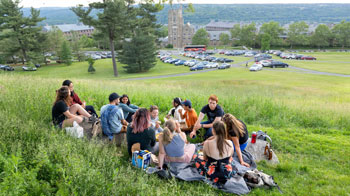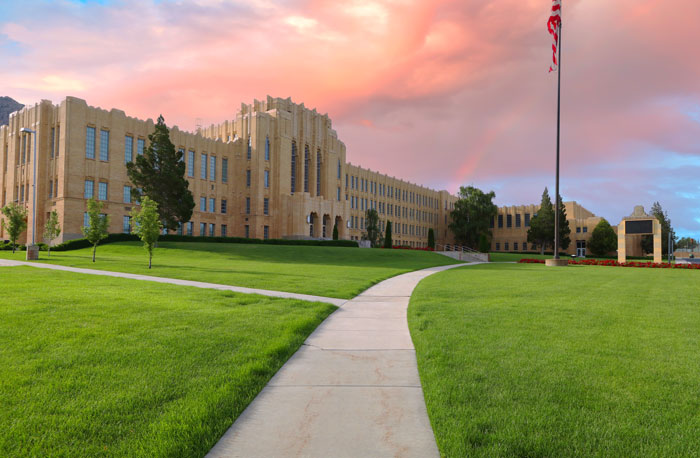A wide sweep of healthy, green lawn symbolizes abundance, healing, peace, and perhaps security and order. Although perceptions of landscapes are changing and can now include pops of yellow and purple flowers in a prairie that meets the sky or desert xeriscaping so little to no water is needed, lawns are still the norm for facilities and campuses across North America.
It’s easy to see in the images we take. Brides and grooms are framed by manicured grass and ponds, graduates throw their caps up while assembled on school greenways, and “curb appeal” usually includes a freshly mown lawn.
The COVID-19 pandemic put a new focus on the benefits of grass, trees, flora and fresh air, and brought people out to parks and nature areas. In areas that are experiencing population growth, new homes, shopping and recreation centers come with grass, even if future sources of water to keep it green are being debated.
Along with the costs of keeping landscaping in top shape, there is the need to reckon with the fuels we have been using to keep the grass neat, as burning gasoline emits carbon dioxide, a greenhouse gas that traps heat in the atmosphere.
The federal Inflation Reduction Act approved by Congress last year includes the goal of cutting greenhouse gas emissions in the United States in half by 2030, along with incentives to get there. Record hot days and flooding from frequent, heavy storms are almost daily reminders that climate change is everyone’s business.

Grounds management professionals must piece together a solution for their facility that meets consumer demand, is resilient when it rains too hard or not enough, and that meets environmental goals as well as financial ones.
“When people think about sustainability, they think, what’s it going to cost?” said Dan Schied, director of grounds at Cornell University, noting that there are many cost-neutral opportunities for grounds professionals and their organizations.
But the cost of not having landscaped retreats is high as well. People need places of respite and calm, said Robert Densley, vice president of sales for a Utah-based company that makes “smart” irrigation control technology.
This is something everyone learned during the pandemic. Now the issue is how to manage green spaces in a way that is good for budgets, people and the planet.
Charge Up & Go
For some the cost is part of doing business sustainably. Schied said Cornell University has a commitment to be carbon neutral by 2035. Its 1,000-acre main campus in Ithaca, N.Y., is a land grant school, which Schied said makes its Sustainability Division inherent to its mission.
Right now, Cornell’s handheld grounds maintenance equipment is 30% electric. And when it comes to keeping that part of the team powered, having students and staff handy to innovate helps.
Schied said students designed a solar trailer to haul and power equipment, and are hoping to plan a solar building that will house the electric groundskeeping fleet as it grows.
Along with helping meet the university’s environmental goals, electric-powered equipment is quieter, Schied reports.
According to Joe Ferris, electrification project manager for a manufacturer of grounds equipment, those in the market for electric mowers have to face the same higher upfront cost that confronts drivers of electric cars.
However, he noted, electric products have lower fuel and maintenance costs compared to gas products, making the total cost of ownership for electric less than a similar gas product.

“We provide a calculator so people interested can calculate what savings they could see with using one of our mowers,” he said.
With gas mowers, the belts that spin the components accumulate wear and tear. Electric mowers utilize direct drive components, or blades and tires that are directly mounted to the motors that spin them. Moving to electric equipment means getting away from the many moving parts and pieces that can fail or need regular maintenance in traditional gas equipment.
“For a landscaper, as soon as the mower breaks, they stop making money and suffer from downtime, which is when workers are on the clock, but sitting around doing nothing because equipment has failed and is broken,” Ferris said.
Also, Ferris noted, the ethanol additive put into gas-powered equipment can cause problems with the small engines used in lawnmowers when they sit idle through winter.
“With electric we don’t have to worry about this or potential downtime or the preventive maintenance it requires,” he said. “So, we have a lower maintenance cost and fewer parts that could fail. The end user can see greater operating efficiencies.”
Further impacting the bottom line, tax credits and other financial incentives can take the sting out of the upfront purchase of electric equipment. According to the Inflation Reduction Act of 2022, businesses and tax-exempt organizations that buy a qualified commercial clean vehicle may qualify for a tax credit of up to $40,000. Many states and local areas have initiatives for the purchase of green lawncare equipment through their environment departments or electric utilities.
Ferris said the grounds management industry is knowledgeable of incentives to switch to electric. “However, the popularity of incentives is growing and can change from year to year, so we offer an up-to-date summary and additional resources with supporting detail for people to further educate themselves.”
The bottom line? Talk to your grounds equipment manufacturer about how best to take advantage of electric equipment, as they’ll be well-versed in the most recent incentives available, as well as all the potential benefits and any challenges associated with the equipment.
Let It Grow

Cost savings was one of the reasons Cornell has now turned 31 of the 1,000 acres of its main campus
into meadow, said Schied. Letting the grass grow was an idea born during the last major economic crisis before the pandemic—the 2008 recession.
Located in the Finger Lakes region of New York, the Ithaca campus is considered one of the most beautiful in the United States, even earning praise from a major travel magazine for its blend of architectural styles, historic landmarks and picturesque surroundings.
Having a campus with terrain helped the grounds department decide where not to mow, mostly in areas that were sloped or otherwise difficult and dangerous to maintain. These areas are now mowed only once per year.
Another earth- and budget-friendly option is to mow longer. Raising the mowing height by an inch can reduce mowing frequency by 20%. But it is important to mow only one-third of the leaf each time to keep the turf from stress that can decrease its drought and heat tolerance.
Both meadows and higher lawns also help to keep rainwater on site.
Schied said there is a lot of calculation needed to make sure your mowing plan helps to meet your environmental and budget goals. On a busy college campus, part of the maintenance formula includes creating spaces for pollinators and desirable wildlife, but care should be taken to avoid attracting non-desirable wildlife close to residential areas, Schied said.
One calculation that does not need to be debated is the decision to communicate what you are doing and explaining why.
“When you do things like this, educate people,” Schied said. Signage around the Cornell campus lets prospective students and existing students, staff and visitors know why a lawn is now a meadow. And it’s hard to ignore a sign that reads “Tall Grass, Small Gas.”
The feedback has been positive, Schied said, noting that there have been many kudos from both visitors and alumni.
Manage the Flow
The grounds Schied manages at Cornell are not only good for storing carbon, holding water and encouraging the work of pollinators in helping with plant reproduction. Landscapes are integral to the places we go for health, recreation and education. Plants, bodies of water and vistas
are critical to mental and physical well-being.
But water requires energy to be filtered, heated and pumped, and all of this increases a facility’s carbon footprint.
Densley said he has heard of people asking if tearing out grass or plants is ultimately the best way to conserve water. But you don’t have to be leading an irrigation company to know that no landscaping is not an option.
“We are talking about an entire ecosystem. We need plants and healthy landscapes,” he said.
What we don’t need, he added, is to water too much or at the wrong time. His company started as a landscaping company, but with the help of talented engineers, the company chose to design a system to help every grounds manager become a water manager.
The system allows facility managers and grounds crews to input their unique conditions, including the kinds of plants and their root systems, type and condition of soil, and if the site is in shade or sun, or sits on a slope.
Sensors monitor local weather conditions and soil moisture levels to automatically adjust the amount of water applied to an area. Data from virtual weather stations across North America are also part of the system’s information feed to devices that can control up to 240 different zones.
“A lot of water management technology does not get used because it is hard to figure out,” Densley said. “Our idea is that the technology will do most of the work.”
The system uses real-time data to check weather every hour, and can even shut off water in the middle of a run cycle if weather conditions change.
“The system lets us predict extremely well what is going to happen on the property,” he said.
As the technology works in 40 states, the system can handle areas prone to drought or those where too much water comes at once.
In Florida, for example, water costs are high, and areas need to be irrigated differently at different times of year. The non-solution that often occurs is overwatering, which threatens landscaping by allowing fungus and other damaging bacteria to grow. With a smart irrigation system in place, Densley said, some sites don’t water the grounds for a whole month, saving not just the biology of the green spaces but money as well.
Dry and drought-stricken areas in the West need to maximize the water that’s available, especially if the region continues to see explosive growth, Densley said. And even places like Hawaii that are surrounded by water need to have enough fresh water for inhabitants and to maintain the paradise that draws millions there every year.
Client feedback through the years has allowed the company to simplify controls and improve reporting. The app that managers can use on their phone has also been streamlined based on user input. “We are always looking for ways to make the software better,” Densley said, referring to both technological innovation and user interface.
The goal is to make sure that everyone is aware of how they are managing water, he explained.
“You can keep your landscapes, but just water them right,” he said. RM



